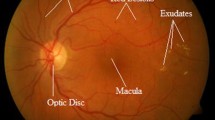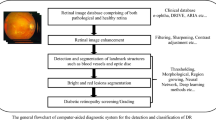Abstract
Diabetes is characterized by constant high level of blood glucose. The human body needs to maintain insulin at very constrict range. The patients who are all affected by diabetes for a long time affected by eye disease called Diabetic Retinopathy (DR). The retinal landmarks namely Optic disc is predicted and masked to decrease the false positive in the exudates detection. The abnormalities like Exudates, Microaneurysms and Hemorrhages are segmented to classify the various stages of DR. The proposed approach is employed to separate the landmarks of retina and lesions of retina for the classification of stages of DR. The segmentation algorithms like Gabor double-sided hysteresis thresholding, maximum intensity variation, inverse surface adaptive thresholding, multi-agent approach and toboggan segmentation are used to detect and segment BVs, ODs, EXs, MAs and HAs. The feature vector formation and machine learning algorithm used to classify the various stages of DR are evaluated using images available in various retinal databases, and their performance measures are presented in this paper.



Similar content being viewed by others
References
Zaki, W. M. D. W., Zulkifley, M. A., Hussain, A., Halim, W. H. W. A., Mustafa, N. B. A., and Ting, L. S., Diabetic retinopathy assessment: Towards an automated system. Biomedical Signal Processing and Control 24:72–82, 2016.
Olson, J. L., Asadi-Zeydabadi, M., and Tagg, R., Theoretical estimation of retinal oxygenation in chronic diabetic retinopathy. Computers in Biology and Medicine 58:154–162, 2015.
Yun, W. L., Acharya, U. R., Venkatesh, Y. V., Chee, C., Min, L. C., and Ng, E. Y. K., Identification of different stages of diabetic retinopathy using retinal optical images. Information Sciences 178(1):106–121, 2008.
Akram, M. U., Khalid, S., and Khan, S. A., Identification and classification of microaneurysms for early detection of diabetic retinopathy. Pattern Recognition 46(1):107–116, 2013.
Acharya, U. R., Mookiah, M. R. K., Koh, J. E., Tan, J. H., Bhandary, S. V., Rao, A. K., Fujita, H., Hagiwara, Y., Chua, C. K., and Laude, A., Automated screening system for retinal health using bi-dimensional empirical mode decomposition and integrated index. Computers in biology and medicine 75:54–62, 2016.
Mahendran, G., and Dhanasekaran, R., Investigation of the severity level of diabetic retinopathy using supervised classifier algorithms. Computers & Electrical Engineering 45:312–323, 2015.
Imani, E., Pourreza, H. R., and Banaee, T., Fully automated diabetic retinopathy screening using morphological component analysis. Computerized Medical Imaging and Graphics 43:78–88, 2015.
Figueiredo, I. N., Kumar, S., Oliveira, C. M., Ramos, J. D., and Engquist, B., Automated lesion detectors in retinal fundus images. Computers in biology and medicine 66:47–65, 2015.
Mookiah, M. R. K., Acharya, U. R., Martis, R. J., Chua, C. K., Lim, C. M., Ng, E. Y. K., and Laude, A., Evolutionary algorithm based classifier parameter tuning for automatic diabetic retinopathy grading: A hybrid feature extraction approach. Knowledge-based systems 39:9–22, 2013.
Kumar, S. J. J., and Madheswaran, M., An improved medical decision support system to identify the diabetic retinopathy using fundus images. Journal of medical systems 36(6):3573–3581, 2012.
Madheswaran, M., and Kumar, S. J. J., An Improved Medical Decision Support System To Grading The Diabetic Retinopathy Using Fundus Images. ICTACT Journal On Image and Video Processing 3(02):502–510, 2012.
Staal, J., Abràmoff, M. D., Niemeijer, M., Viergever, M. A., and Van Ginneken, B., Ridge-Based Vessel Segmentation in Color Images of the Retina. IEEE Transactions on Medical Imaging 23(4):501–509, 2004.
Hoover, A. D., Kouznetsova, V., and Goldbaum, M., Locating blood vessels in retinal images by piecewise threshold probing of a matched filter response. IEEE Transactions on Medical Imaging 19(3):203–210, 2000.
Decencière, E., Zhang, X., Cazuguel, G., Lay, B., Cochener, B., Trone, C., Gain, P., Ordonez, R., Massin, P., Erginay, A., Charton, B., and Klein, J.-C., Feedback on a publicly distributed database: the Messidor database. Image Analysis & Stereology 33(3):231–234, 2014.
Kauppi, T, Kalesnykiene, V, Kamarainen, JK, Lensu, L, Sorri, I, Uusitalo, H, Kälviäinen, H & Pietilä, J 2006, 'DIARETDB0: Evaluation database and methodology for diabetic retinopathy algorithms', Machine Vision and Pattern Recognition Research Group, Lappeenranta University of Technology, Finland, pp.134.
Kauppi, T, Kalesnykiene, V, Kamarainen, J.-K, Lensu, L, Sorri, I, Raninen A, Voutilainen R, Uusitalo, H, Kälviäinen, H & Pietilä, J 2007, 'DIARETDB1 diabetic retinopathy database and evaluation protocol, in proceedings of the eleventh conference on Medical Image Understanding and Analysis, pp.1-10.
El Abbadi, N. K., and Al Saadi, E. H., Blood vessels extraction using Mathematical Morphology. Journal of Computer Science 9(10):1389–1395, 2013.
Saleh, M. D., and Eswaran, C., An automated decision-support system for non-proliferative diabetic retinopathy disease based on MAs and HAs detection. Computer methods and programs in biomedicine 108(1):186–196, 2012.
Dua, S., Acharya, U. R., Chowriappa, P., and Sree, S. V., Wavelet basedenergy features for glaucomatous image classification. IEEE transactions on information technology in biomedicine 16(1):80–87, 2012.
Acharya, U. R., Mookiah, M. R. K., Koh, J. E., Tan, J. H., Noronha, K., Bhandary, S. V., Rao, A. K., Hagiwara, Y., Chua, C. K., and Laude, A., Novel risk index for the identification of age-related macular degeneration using radon transform and DWT features. Computers in biology and medicine 73:131–140, 2016.
Santhi, D., Manimegalai, D., Parvathi, S., and Karkuzhali, S., Segmentation and classification of bright lesions to diagnose diabetic retinopathy in retinal images. Biomedical Engineering/ Biomedizinische Technik 61(4):443–453, 2016.
Author information
Authors and Affiliations
Corresponding author
Ethics declarations
Conflict of Interest
This paper has not communicated anywhere till this moment, now only it is communicated to your esteemed journal for the publication with the knowledge of all co-authors.
Ethical approval
This article does not contain any studies with human participants or animals performed by any of the authors.
Additional information
Publisher’s Note
Springer Nature remains neutral with regard to jurisdictional claims in published maps and institutional affiliations.
This article is part of the Topical Collection on Patient Facing Systems
Rights and permissions
About this article
Cite this article
S, K., D, M. Distinguising Proof of Diabetic Retinopathy Detection by Hybrid Approaches in Two Dimensional Retinal Fundus Images. J Med Syst 43, 173 (2019). https://doi.org/10.1007/s10916-019-1313-6
Received:
Accepted:
Published:
DOI: https://doi.org/10.1007/s10916-019-1313-6




